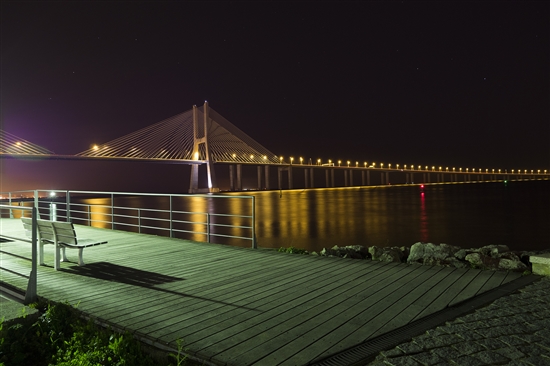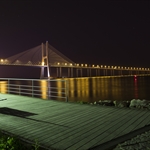- Home
- All challenges
- Picture of the month
- April 2016 - Lights at night
- Vasco da Gama Bridge, Lisbon
MyOMSYSTEM Exif Image Data
| Camera: | E-M1 |
| Lens: | OLYMPUS M.12-40mm F2.8 |
| Aperture: | f/4 |
| Focal Length: | 12 mm |
| Shutter speed: | 15/1 s |
| ISO: | 200 |
| Flash: | Flash did not fire, auto mode |
| Taken: | 2016:04:08 15:39:55 |
| Licence: | You can contact me if you are interested in this or that picture. |
MyOMSYSTEM Report Abuse Link
MyOMSYSTEM picture description and tags



Comments
A Ponte Vasco da Gama é uma ponte sobre o rio Tejo,na área da Grande Lisboa, ligando Montijo e Alcochete a Lisboa e Sacavém, muito próximo do Parque das Nações, onde se realizou a Expo 98. Inaugurada a 29 de março de 1998, a ponte é a mais longa da Europa e é atualmente a nona mais extensa de todo o mundo, com os seus 17,3 km de comprimento, dos quais mais de 14 estão sobre as águas do estuário do Tejo. Na sua inauguração foi servida uma feijoada que teve direito a inscrição no Guinness World Records.
O vão (comprimento do tabuleiro) do viaduto central é de 420 m. Foi construída a fim de constituir uma alternativa à ponte 25 de Abril para o trânsito que circula entre o norte e o sul do país na zona da capital portuguesa.
Aquando da sua construção foi necessário tomar especiais cuidados com o impacto ambiental, visto que atravessa o Parque Natural do Estuário do Tejo, uma importante área à escala europeia de alimentação e nidificação de aves aquáticas. Foi também necessário proceder-se ao realojamento de 300 famílias.
O nome da ponte comemora os 500 anos da chegada de Vasco da Gama à Índia, em 1498.
É uma das mais altas construções de Portugal, com 155 m de altura.
The Vasco da Gama Bridge (Portuguese: Ponte Vasco da Gama; pronounced: is a cable-stayed bridge flanked by viaducts and rangeviews that spans the Tagus River in Parque das Nações in Lisbon, capital of Portugal. It is the longest bridge in Europe (including viaducts), with a total length of 17.2 kilometres (10.7 mi), including 0.8 kilometres (0.50 mi) for the main bridge, 11.5 kilometres (7.1 mi) in viaducts, and 4.8 kilometres (3.0 mi) in dedicated access roads. Its purpose is to alleviate the congestion on Lisbon's other bridge (25 de Abril Bridge), and to join previously unconnected motorways radiating from Lisbon.
Construction began on February 1995; the bridge was opened to traffic on 29 March 1998, just in time for Expo 98, the World's Fair that celebrated the 500th anniversary of the discovery by Vasco da Gama of the sea route from Europe to India.
Construction and cost
The $1.1bn project was split in four parts, each built by a different company, and supervised by an independent consortium. There were up to 3,300 workers simultaneously on the project, which took 18 months of preparation and 18 months of construction. The financing is via a build-operate-transfer system by Lusoponte, a private consortium which receive the first 40-year of tolls of both Lisbon bridges. Lusoponte's capital is 50.4% from Portuguese companies, 24.8% French and 24.8% British. As of June 2014, the toll is €2.65 per passenger car (up to €11.55 per truck (August 2013)) northbound (into Lisbon). There is no toll for southbound traffic.
The bridge has a life expectancy of 120 years, having been designed to withstand wind speeds of 250 km/h (155 mph) and hold up to an earthquake 4.5 times stronger than the historical 1755 Lisbon earthquake (estimated at 8.7 on the Richter scale). The deepest foundation piles, up to 2.2 m (7.2 ft) in diameter, were driven down to 95 m (312 ft) under mean sea level. Environmental pressure throughout the project resulted in the left-bank viaducts being extended inland to preserve the marshes underneath, as well as the lamp posts throughout the bridge being tilted inwards so as not to cast light on the river below.
Show more comments (1)